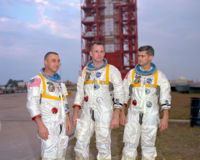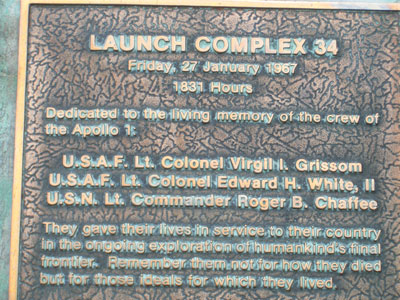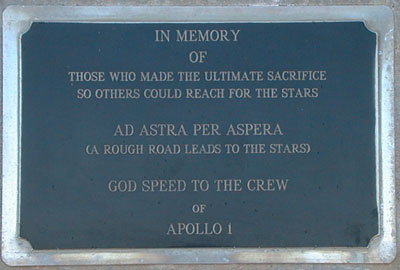影片对白 Man has traversed the reaches of outer space, and that man is a Communist.
考考你 小试牛刀
5. Open mike
这里是指“开着的麦克风”,例如:Do not rustle papers, pour out glasses of water, drum your fingers on the work surface, etc., in front of an open mike. Avoid noisy bangles in the booth.
6. On the line
这里是指“on the phone”,“在打/接电话”。
7. There's some situation with the test.
Situation 本意指“形式,情况,事态(通常指不好的)”,这句话的意思是:“测试出了点情况”。 我们也可以用这句话来表示任何事物出了情况:There’s some situation with the contest.
文化面面观
Apollo 1 阿波罗一号灾难纪实
继苏联之后,美国也实现载人飞船在外太空飞行。之后,为了能在太空计划上胜过苏联,美国加紧了登月的步伐。阿波罗一号是登月计划中第一艘飞船的代号。
Apollo 1 is the official name given to the Apollo/Saturn 204 (AS-204) spacecraft, destroyed by fire during a training exercise on January 27 1967, at Pad 34 (Launch Complex 34 at Cape Canaveral - then known as Cape Kennedy) atop a Saturn IB rocket. Its crew were the astronauts selected for the initial Apollo program mission and all three died in the accident: Command Pilot Virgil I. "Gus" Grissom, Senior Pilot Ed White, and Pilot Roger B. Chaffee.
Crew

|
Apollo 1 crew portrait
(L-R: Grissom, White and Chaffee) |
Virgil Grissom (flew on Mercury-Redstone 4 & Gemini 3), Command Pilot
Ed White (flew on Gemini 4), Senior Pilot
Roger B. Chaffee (never flew in space), Pilot
The accident
The "plugs-out" test planned for January 27, 1967, was never actually carried out, as the fire took place before connections to the Apollo-Saturn were withdrawn.
The Apollo 1 Command Module was a "Block I" design, built for spaceflight but never intended for a trip to the moon, as it lacked the necessary docking equipment.
Immediately prior to the accident, the crew members were reclining in their horizontal couches, running through a checklist of things they would do in space while a communication system problem was being fixed. At 6:31 (23:31 GMT) a voice (now believed to be Chaffee's, as his was the only clear channel) was heard over the COM link, "We've got fire in the cockpit." A few seconds later, the transmissions ended with a cry of pain. On the television monitors, Ed White was seen attempting to open the hatch.
The fire
 |
| Apollo 1 plaque that is attached to Launch Complex 34 |
The fire spread quickly and, within seconds, was out of control. As a result of toxic smoke and malfunctioning gas masks, ground crew needed five minutes to open the hatch and suppress the flames. The fire had melted the astronauts' nylon space suits and the air lines which connected them to the capsule's life support systems. Grissom's and White's suits were found to have fused together. It was evident from how the bodies lay that they had tried to get out, but they never had a chance. Ed White, who was supposed to open the hatch, was partway out of his harness and had apparently made an effort to escape. The procedure would have had Grissom lower White's headrest, and White proceed to unlatch over 12 bolts to release the hatch. Indeed, even if he were to accomplish that feat, the internal pressure had risen so high that the inward-opening hatch could not have been opened. Chaffee's job was to begin shutting down the spacecraft and maintain communications with ground control. He was found dead still strapped into his right hand seat. Only 17 seconds from the first call of "Fire!", all three were dead.
According to the Report of the Apollo 204 Review Board — Appendix D Panel 11, Grissom suffered third degree burns on 36% of his body (1st, 2nd and 3rd degree burns covered 60% of his body) and his spacesuit was 70% destroyed. White suffered third degree burns on 40% of his body (1st, 2nd and 3rd degree burns covered 48% of his body) and his spacesuit was 25% destroyed. Chaffee suffered third degree burns on 23% of his body (1st, 2nd and 3rd degree burns covered 29% of his body) and his spacesuit was 15% destroyed. However, it was later confirmed that the crew had actually died of smoke inhalation rather than burns.
 |
| Second Apollo 1 plaque that is attached to Launch Complex 34 |
The company that produced the command module, North American Aviation, had originally suggested that the hatch open outward and be able to open with explosive bolts in case of emergency. They had also suggested that the atmosphere be an oxygen/nitrogen mixture, like on the earth's surface. NASA didn't agree, arguing that the hatch could be accidentally opened (this is what caused Liberty Bell 7 — ironically, piloted by Grissom — to sink into the ocean during splashdown recovery operations; Grissom himself argued that the hatch should be stronger, more secure, and harder to open), and that if too much nitrogen were released into the atmosphere, the astronauts would pass out and then die. They also argued that since a pure oxygen atmosphere was used safely in Mercury and Gemini, it should be safe to use for Apollo. Furthermore, such a design saved weight.
影片对白 Man has traversed the reaches of outer space, and that man is a Communist.
考考你 小试牛刀